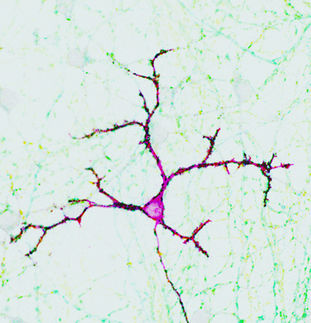Revealing the regulating mechanism behind signal transduction in the brain
Advertisement
Our brain consists of billions of cells that continually transmit signals to each other. This dynamic process - which enables us to learn, remember, and so much more - works only when the brain cells make contact correctly, or, in other words, when there is a good ‘synapse’. An essential element in this process is a controlled protein production along with the synapse. VIB researchers connected to the Center for Human genetics (K.U.Leuven) are now discovering how the Fragile X protein (FMRP) ensures that protein production is controlled at synapse and regulated by brain activity. Their findings are being published in Cell.
Our ‘gray matter’ has yet to divulge all its secrets. For example, we do not yet fully understand how we are able to learn and remember things. We do know that dendrites and axons play a crucial role by making contact with each other in so-called synapses, through which signals are transmitted between different brain cells. Moreover, for properly functioning brain activity at a synapse, the right proteins must be present in the right concentrations. It has been known for some time that the brain’s cells are able to produce proteins directly at the place where they are needed. But exactly how the subtle regulation of this process works is still to be discovered.
Claudia Bagni (VIB, K.U.Leuven, University of Rome Tor Vergata) has been studying the FMRP protein for years now. The absence of FMRP leads to the Fragile X syndrome, a mental handicap afflicting a thousand Belgians. In this particular syndrome, the synapses are not well-formed. So, it is no surprise that FMRP plays an important role in the development and functioning of the brain. The researchers have already shown that FMRP suppresses protein production, but how has remained a mystery.
Ilaria Napoli and her colleagues from Claudia Bagni’s group are now discovering that FMRP cannot perform its job without another protein: CYFIP1. In a previous study, Claudia Bagni and her collaborators have shown that a reduced amount of FMRP in the brain increases the production of some neuronal proteins. The VIB researchers in Leuven have now elucidated the mechanism behind this. They have found that complexes of FMRP and CYFIP1 are located at the synapses and together suppress the local production of a number of proteins.
In the transduction of signals between brain cells, i.e. synaptic activation, CYFIP1 is released from the complex, whereby FMRP can no longer exercise its suppressing action. This is the impetus for the production of the proteins that are under the control of FMRP.
A change in the concentration of FMRP or CYFIP1 causes a disruption in this strict regulation of protein production. This, in its turn, causes diseases like Fragile X syndrome and Autism. Indeed, CYFIP1 has been recently found associated to Autism.
With their research, Napoli and Bagni are shedding a bit more light on synapses in the brain - giving us more insight into learning and remembering, and also into a number of ‘brain disorders’. We now understand that, through its absence, FMRP plays a role in diseases like Fragile X syndrome and Autism.
Original publication: Napoli et al., "The Fragile X Syndrome Protein represses activity-dependent translation through CYFIP1, a new 4E-BP"; Cell 2008.




























































